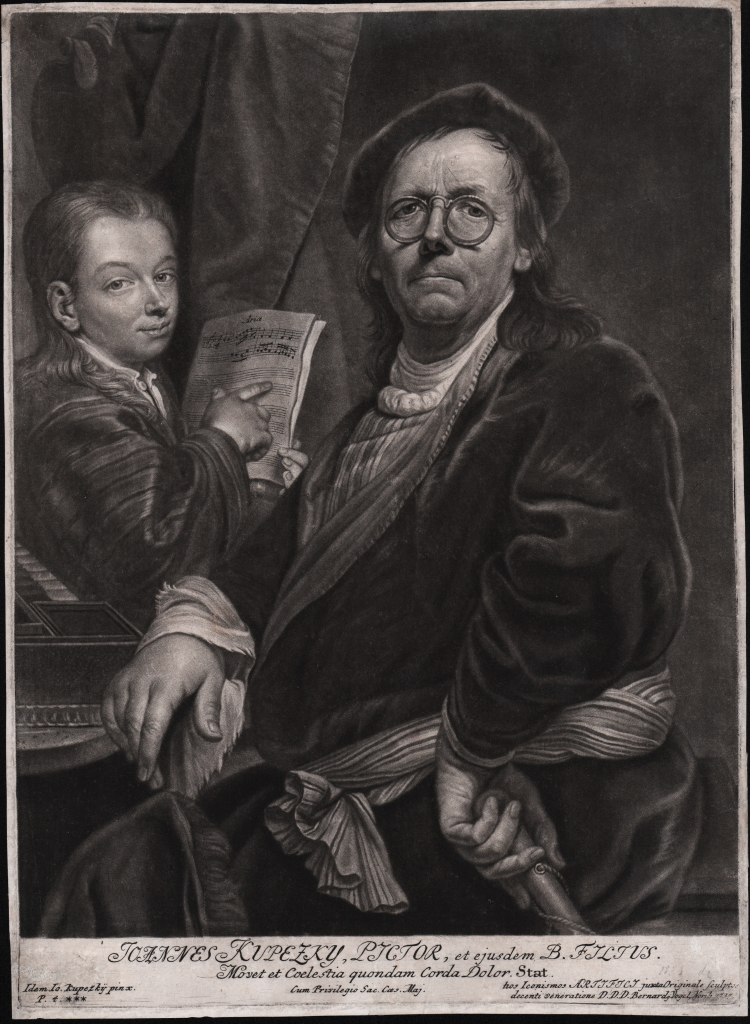



| Riferimento: | S41938 |
| Autore | Bernhard Vogel |
| Anno: | 1737 |
| Misure: | 235 x 350 mm |


| Riferimento: | S41938 |
| Autore | Bernhard Vogel |
| Anno: | 1737 |
| Misure: | 235 x 350 mm |
Maniera nera, 1737. Nel margine inferiore, al centro: IOANNES KUPEZKY, PICTOR, et eiusdem B. FILIUS/ Movet ed Coelestia quondam Corda Dolor Stat/ Cum Privilegio Sac. Caeas. Maj.
A sinistra: Idem Io. Kuperzky pinx/P. 4 *** A destra: hoc Iconismos ARTIFICI iuxta Originale Sculptos/decenti veneratione DDD Bernardq Vogel, Norib 1737.
Da un dipinto di Johann Kupezky. Ottimo esemplare, completo oltre la linea del rame.
Ritratto del pittore Johann Kupezky (1667 – 1740); di tre quarti, seduto a sinistra su uno sgabello, con la testa rivolta verso lo spettatore, tiene un bastone con una corda nella mano sinistra, indossa grandi occhiali rotondi e un abito con ampia cintura a pieghe slacciata; suo figlio, Christoph Johann Friedrich, seduto a una spinetta con il busto di profilo a destra e la testa rivolta di tre quarti a destra, guarda verso lo spettatore, indicando con l'indice della mano destra un foglio manoscritto musicale, intitolato "Aria", tenuto nella mano sinistra.
"This famous portrait, also known as the Portrait with Spectacles, has its origins in a self-portrait by the Bohemian painter, Johann Kupezky (1667–1740), who was active from 1723 in Nuremberg, where he was held in great esteem. The painted version is now in the Staatsgalerie in Stuttgart (Inv. No. 379). Kupezky, who is wearing a velvet beret and a comfortable dressing gown tied with a sash around his waist, has adopted a self-confident pose. The artist was undoubtedly inspired by Rembrandt’s self-portraits. While his powerful, stocky figure dominates the scene, it is above all the rigorous and unsparing psychological characterisation of his person which lends a unique touch to this work of art. The furrowed brow, the melancholy gaze behind the horn-rimmed spectacles and the turned-down corners of his mouth all point to introspection and painful reflection. The reason for this was undoubtedly the passing of his son, Christian Johann Friedrich Kupezky, who died of smallpox in 1733 at the age of just seventeen.
In this second state the figure of his son has been added to the composition. With his right hand the boy points meaningfully at the score of a composition for spinet, the scene symbolising the cultivated atmosphere and domestic harmony which must once have reigned in the Kupezky household. The author of this mezzotint, the engraver Bernhard Vogel, ranked among the foremost German reproductive engravers of his time. Active alternately in Augsburg and Nuremberg, he was known above all for an anthology with mezzotints after inventions by Kupezky, in which Valentin Daniel Preissler was also involved. These reproductive engravings were of considerable importance for the dissemination and reputation of Kupezky’s paintings and made his name known beyond southern Germany" (cfr. N. Teeuwisse, Selected Works XVI, pp. 62-63, n. 25).
|
Nagler 12, II.
|
Bernhard Vogel (19 December 1683 – 13 October 1737)
|
Era un incisore tedesco i cui interessi principali erano scene di genere e ritratti. Vogel nacque a Norimberga. Studiò sotto Weigel e Heisse ad Augsburg. Nel 1745 alcune sue incisioni su Jan Kupecký furono pubblicate dal pittore e incisore tedesco Valentin Daniel Preissler. Morì ad Augusta all'età di 53 anni.
|
|
Nagler 12, II.
|
Bernhard Vogel (19 December 1683 – 13 October 1737)
|
Era un incisore tedesco i cui interessi principali erano scene di genere e ritratti. Vogel nacque a Norimberga. Studiò sotto Weigel e Heisse ad Augsburg. Nel 1745 alcune sue incisioni su Jan Kupecký furono pubblicate dal pittore e incisore tedesco Valentin Daniel Preissler. Morì ad Augusta all'età di 53 anni.
|